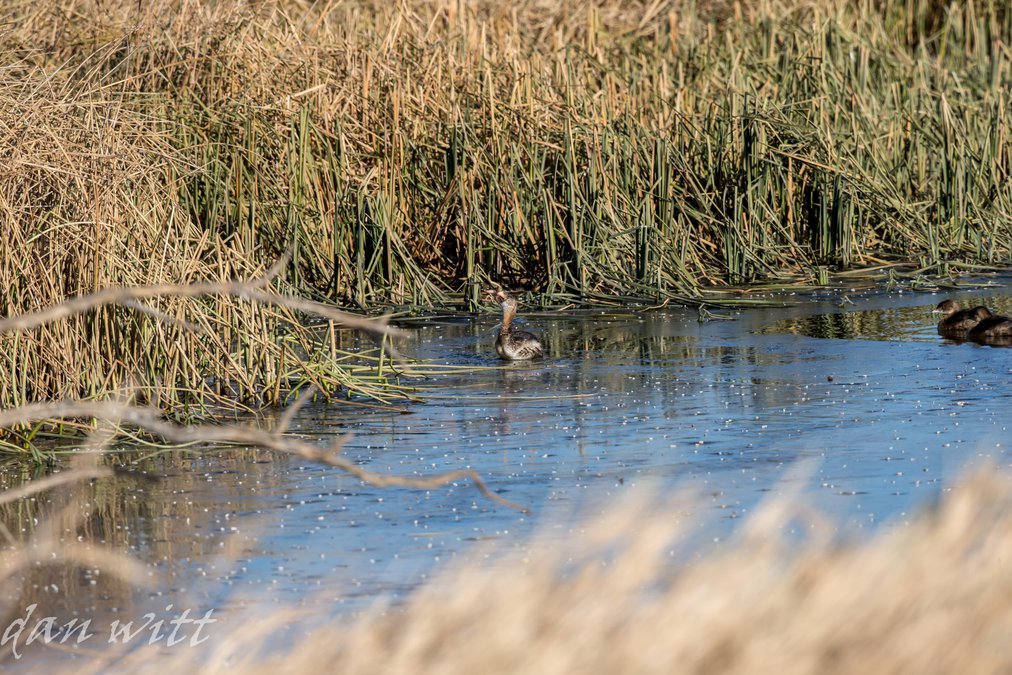



I would bet that you don’t know much about grebes — in fact, if you don’t look carefully you might never identify one in a group of ducks such as teal or ruddy ducks. They are shy but not completely reclusive like the Black Rail or some of those birds that are life birds the very few times they make a mistake and give you a peek.
Grebes are the unsung heroes of our marsh. There are several different grebes in the USA. I will tell you a little bit about the grebes that come through the Bottoms and Quivira.
The most common grebe is the Pied-billed grebe. This is a grey/brown bird with a dark ring around the beak most of the time they are here. They are a cousin to loons which are larger and stronger birds. They barely have tail feathers and have lobed toes — not webbed like ducks. Some of these birds (Western and Clark’s grebe) are unable to walk on land. The young ride on the parent’s backs for a time after hatching. They feed on small aquatic animals which they access by diving relentlessly. In fact, diving is their preferred method of escaping harm or danger — and they can stay under the water or just have their head sticking out with bodies submerged.
It is great fun to watch these little guys. I have a series of pictures of one trying to swallow a frog while standing on the frozen surface of the marsh. He fell over backward about five times before deciding the frog was too big for his throat. That happened right by headquarters at the Bottoms.
The red-eyed monsters of the marsh are the Horned Grebe and the Eared Grebe. It is hard to believe how red their eyes really are. They have different head shapes and go through several color phases of breeding and non-breeding plumage with different color patterns that are very important to serious birders and grebe lovers — I just stop what I’m doing and watch these strikingly beautiful birds. They shyly meander around the edges of the cat tails and dive and feed and show off their amazing red eyes. I’ve always been a sucker for these red-eyed beauties.
The grebe that will completely stop your clock is the Western Grebe. It is a beautiful large slender bird with a long neck and a really thin bill. It has precise black and white plumage and the patented grebe red eye. They tend to be shyer than the other grebes and stay mostly on pool 1 and 2 in the “big water” areas of our marsh. We don’t get to see them very often, but when I spot a pair doing their elegant mating ballet and walking on water to express their affection for each other — I’m hooked!!! My friend Curran has a friend who is a guide on Lake McConaughy in Nebraska. We went up last year to fish with him and not catch walleye (weather — not his fault). There were several hundred pair of Western Grebes on that lake. I’ve never been able to get close enough to get the pictures I dream about, and we were able to drive the boat within 20 yards of several pair. Naturally, I didn’t have my camera — I was busy fishing. He says they come there every year and nest in the upper end of the lake. You can bet I will be going back with the camera when they arrive this year!
Get your cameras out and your cool weather gear ready. You can feel the urgency in the marsh. Turkey season is about to open and my Canadian buddies are headed this way with their traditional archery gear. The snow geese are gone, ducks are everywhere, grebes are here and pelicans are arriving. I almost get out of breath just anticipating the amazing things we will see. Prairie chickens are starting on the leks—so much to do and so little time! Keep your eyes open and watch for the grebes — they are mighty special little birds!
Doc
Doctor Dan Witt is a retired physician and nature enthusiast.





